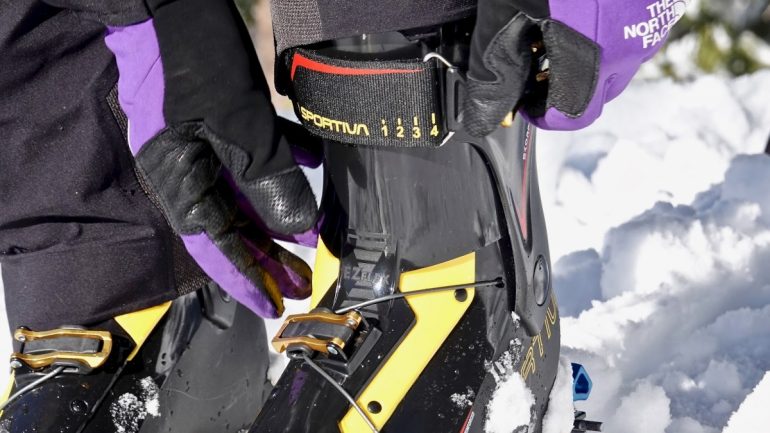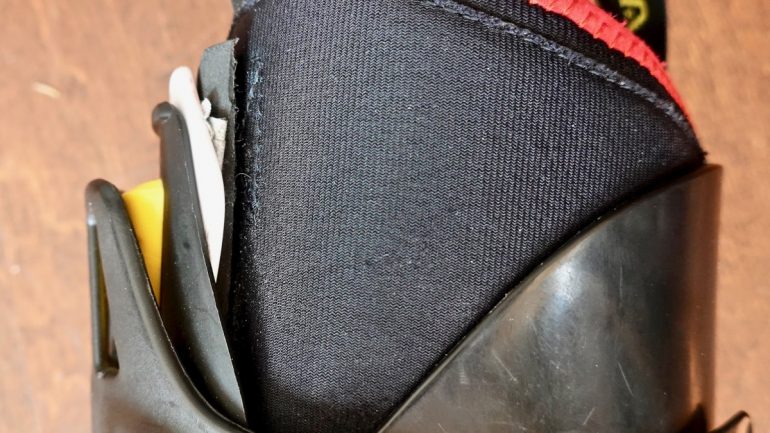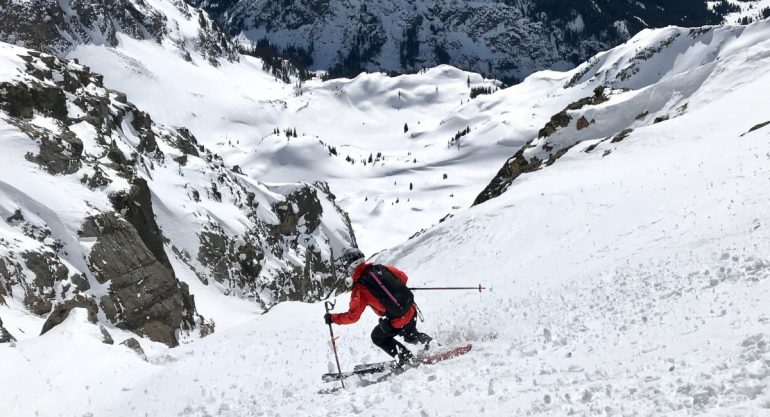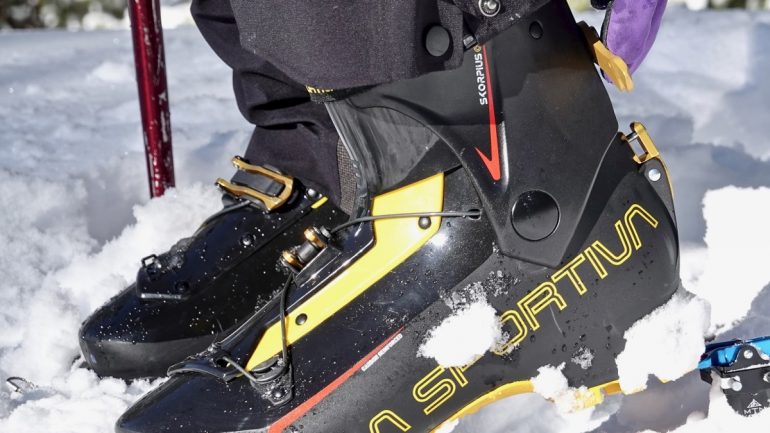
With a few mods, the La Sportiva Skorpius CR is a strong contender for the elusive quiver of one boot for a lighter guy like myself.
Not-too-light is right for versatility
Two seasons ago I went to a two touring boot approach — the Scarpa Alien RS for fast days with faster friends on light skis, and the Hoji Pro Tour for normal strong pacing and pushing a bigger ski. This approach worked well and opened up the quiver a bit, but, as picky as I am with boots, it was a ton of effort. It also required adjusting my style depending on the boot of the day. I decided to replace the two-boot system with a long term test of the new La Sportiva Skorpius CR this season, hoping to go back to a single boot for all but resort and resort accessed backcountry. The Scarpa F1 has been the best single touring boot quiver for me in the past. Could the Skorpius be the next one?
Doug danced around in the Skorpius CR before there was any snow on the ground and gave us his initial impressions. Aaron Mattix has also covered the less stiff La Sportiva Solar extensively now. Here’s my take, including some modding and plenty of on-snow performance.
Design
The Skorpius CR sits at the high end of its weight class, and for good reasons — skiing performance and durability. The boot closure is entirely plastic (carbon reinforced grilamid), not the cloth gaiter that wraps across the shin of others. These designs ski brilliantly considering there is nothing in front of your lower shin, but they put the nail in the coffin for any hopes of a progressive feeling flex. Designers often use BOAs and/or cord systems in this class. I have found this sacrifices tightening leverage and gives you more small things to break. Buckles and thick cables, albeit heavier, simply work better with the amount of forces we are putting into ski boots.
La Sportiva has done a great job making a fully shelled and buckled boot as light as possible without worrying about advertising it as “sub-kilo”. The Spider Buckle Evo is a cool two-stage buckle system first seen on the Sytron. The cable crosses the top of the foot twice at four different anchor points, one of which is the buckle located directly above the upper-mid foot. The first short buckle lever is a walk position offering a slight clamping, then a longer buckle uses a multi point mechanical advantage to cinch the foot down for skiing.
The cuff is closed by a single buckle velcro strap that offers a giant range from preferred ski tightness to unrestricted walking. Being velcro, the strap is infinitely adjustable and offers measurements to help positioning. On the medial side of the boot, opposite the buckle, the strap connects to a small hook built in to the shell plastic via a 2mm steel wire loop. The wire loop has a plastic bit that clips to the shell preventing the strap from coming free while in walk mode. Doug mentioned that he had seen issues with this in previous renditions, but so far so good for me. Top the closures off with a simple velcro power strap — I’m always a fan of a power strap despite transition issues. In total, the shell and buckles without the liner weigh 970g in my 27, about the weight of the entire Alien RS.
The Swing Lock walk/ski lever is phenomenal. The industry standard lever that flips vertically works fine, but presents issues with pants sometimes, even more so the old, and now revisited Dynafit ultra-lock system. The Swing Lock is never more than a centimeter out from the boot and can be flipped underneath pants, along with the cuff buckle. An additional bonus: the Swing Lock can be locked in to ski position without interfering with a rear crampon lever, helpful for giving the calves a break on steep and long booters. This is not the case for many boot/crampon match ups. Speaking of crampon fit, La Sportiva’s very rockered soles have caused issues in the past. There is a very slight gap, less than 1mm, between the sole and toe plate of my CAMP XLC Nanotech automatics. I didn’t have any problems on my only day with them so far — breakable crust, firm crust and a bit of rock scrambling in crampons withstood. Perhaps some JB Weld and a super thin sheet of aluminum would fill the space?
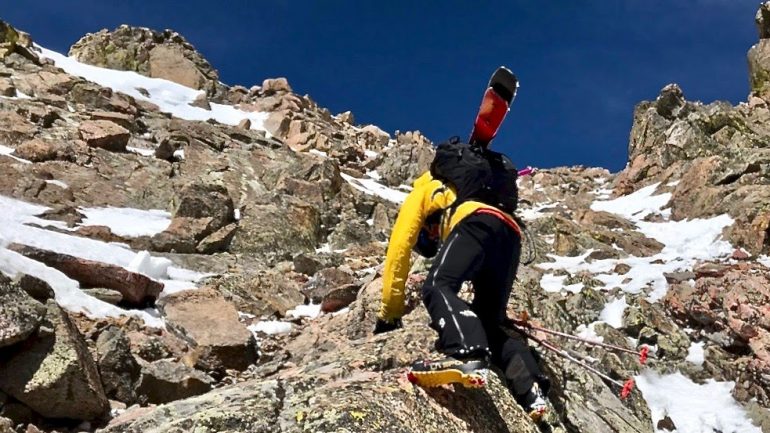
La Sportiva’s in-house Grip-Guard soles getting the job done on this scramble. Color coordination an added bonus. The sun made for a crampon free ascent on this one.
The liner is basic and comfortable. At 212 grams without a footbed, the liner falls in line with the design theory of light but not overdone. Fine by me, as I find that more and more liners these days turn to mush a few weeks after seducing you with their low weight. The cuff and tongue have a nice dual density design with a very firm exterior foam. A softer foam with mesh-like face fabric inside make up the remainder. It is thin and therefore moves well at the ankle. I am starting to feel the pack out begin, particularly in the rear of the heel.
Fit
The Skorpius fit me comfortably right out of the box, in a size 27. I measure 27 mondo, yet have always sized down to 26/26.5 when shell sizes break traditionally as in the Skorpius. Sportiva’s Skorpius (and Dynafit’s new TLT 8) appear to have done the downsizing for us this season. The 102mm last is about right for a touring boot on my 101mm wide forefoot. The shell has a nice toe box and taper from the metatarsals back to the heel. That said, comfortable out of the box isn’t exactly my cup of tea for a ski boot, it should be borderline. Putting the boot on in the morning, I want to wonder if it’s too tight, and then after a day of skiing know it’s just right.
After a quick eight-minute heat mold with thin toe caps, I padded the inner and outer ankle with dense 4mm adhesive foam, using shapes from prior liner’s pads as a guide. Once padded I felt good about a test run. I adjusted the forward lean to it’s most forward 16 degree position and hit the snow.
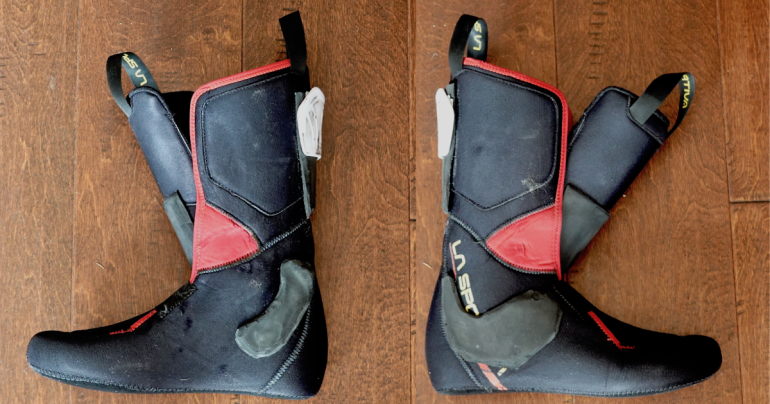
Current level of padding? Heavy. Medial and lateral ankle, calf, lower shin. Read more below about the spoiler addition.
On snow
Not to my surprise, the Skorpius walks extremely well. I never reach the limits of the claimed 68 degree range of motion which is split evenly 35/33 front and back. I generally start my tour with the spider buckle completely open. Then after warming up a bit, or reaching a side hill portion, flip it over into the walk position.
Transitions are a breeze, and on my first day I was ready to drop in to the cold early season powder. The spider buckle clamped my foot much better than any BOA has pretended to and the upper was plenty stiff to drive my Dynafit Beast 108s. There was something missing though, a familiar hole in the downhill performance of 1 kilo boots. It skied like a light boot — upright and rigid. I found myself really having to work to stay in the sweet spot even with the forward lean adjustment maxed out. I adapted my skiing style and ripped around in the powder, but figured that I had not found my new favorite boot.
On the final lap of my first day in the Skorpius, I left the power straps loose, half out of curiosity and half out of laziness. Wow, what a difference! I drove my knees into the fall line and the boot flexed beautifully into the perfect position without collapsing. Though I had a noticeable gap behind my calf, I was beyond stoked on the Skorpius and couldn’t wait to get to the work bench and capitalize on this finding.
As I mentioned before, I am a power strap addict, generally bolting on tighter, taller, and beefier straps to all of my boots, as seen in this Alien RS concoction. In a huge departure, I pulled the straps from the Skorpius. I did not want to be ratcheted against the upright design and stiff rear spine. I then set out to pad up the rear of the liner even further. I placed a roughly 11x6cm piece of the dense 4mm foam on the rear of the liner between the flex point and the top of the shell. Still not quite satisfied with the lean, and feeling some friction between the foam and shell in walk mode, I scrounged up a tapered 1.5-3mm hard plastic spoiler from a Head alpine liner. The spoiler took care of that last bit of desired forward lean and eliminated the friction.
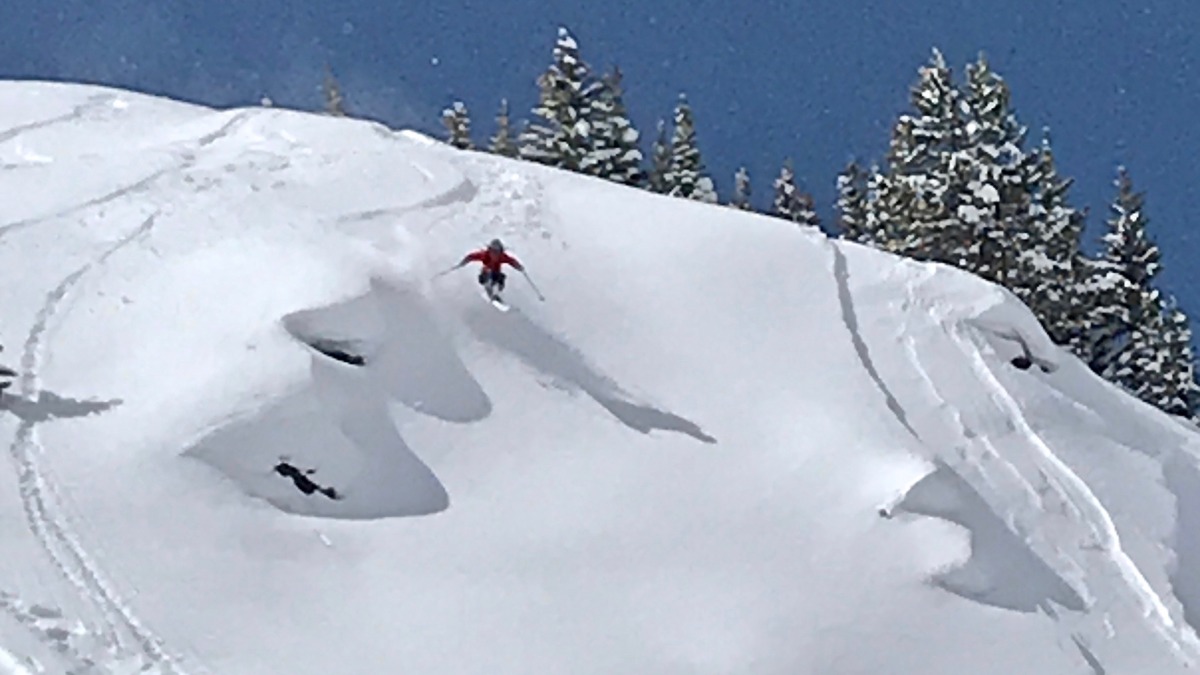
Lo-fi photo for Hi-fi times. Skorpius matched with Dynafit Beast 108 makes for a light amateur freeriding setup.
Many boots in this class would simply bottom out if they were shimmed forward into an alpine position and used a single velcro strap across the mid shin. The yellow bit of plastic in front of the ankle is a softer durometer that backs up the very thin “EZ-Flex” zone in the otherwise stiff and tall tongue. That combination is supportive and progressive. We have heard reports of this flex point cracking in other boots, but there are no signs of it here so far. The build is laterally stiff, but I think the power strap might be missed in steep and firm snow where skis are loaded while across the fall line more often. We just started skiing steep in these parts, the single upper strap felt fine in high angle sun softened alpine neve snow and early stage melt freeze snow (cream corn if you will) while driving the new Atomic Backland 100 in a 180cm length.
The Skorpius CR competes with the Scarpa Alien RS (or forthcoming F1 LT), Atomic Backland Carbon, Fischer Traverse Carbon, etc, and does so in terms of range of motion and weight. I am getting a next-class-up ski performance out of this boot, something more like the F1. The Scarpa F1 has better cuff and shin feel than the Skorpius, but bulges noticeably in the lower when fully taking advantage of the upper boot’s power. The Skorpius’ foot retention is much greater, thanks to the spider buckle and fully carbon reinforced plastic lower. Given this nearly even trade off in ski performance for a light guy like myself, and the huge uphill range of motion, I prefer the Skorpius CR over the F1 as an every day boot. Spanning two boot classes in the ideal directions? That’s a great achievement, I’ll take the extra 200+ grams over it’s lighter competitors.
SPECS
Weight: 1195 g
Shell and Cuff: Carbon Reinforced Polymer (Grilamid® / Carbon)
Flex: 100
Available Sizes: 24 – 31.5 (half sizes)
Last: 102
Range of motion: 68°
Forward lean: 3 positions (12°, 14°, 16°)
Buckles: SWING-LOCK Closure System™/ Spider Buckle Evo™/ Optional power strap
Sole: La Sportiva Grip Guard™ (complies with ISMF standards)
Binding Compatibility: TECH, AT & TR2
MSRP: $799.99
Shop for it.
On March 22nd 2021, Gary Smith tragically died in an avalanche outside of Beaver Creek Resort in Colorado. Since 2018, Gary has been a frequent and insightful contributor to WildSnow. From Christmas Eve spent at the Wildsnow Field HQ cabin, to testing gear and sharing his love for steep skiing around the world, he was a pillar of the ski touring community and will be greatly missed.

